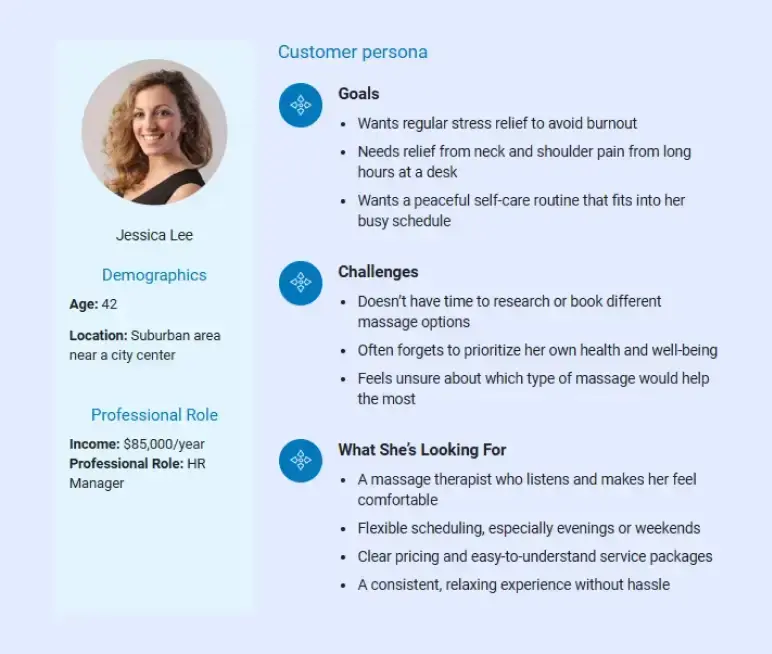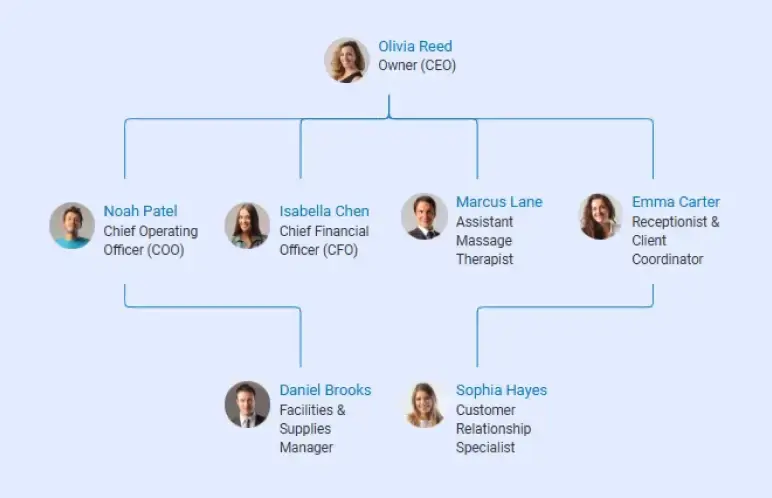Most people don’t even notice how tense they are—until they can’t turn their neck without wincing.
Tight muscles, headaches, sleepless nights—it builds up before they even notice. That’s why today, people aren’t just looking for relaxation. They’re trying to get their bodies back.
That’s where you come in. This growing demand opens a big door for you to build a successful massage therapy business.
But to grab the opportunity, you’ll need a clear and solid business plan to guide you.
Not sure where to start?
This massage therapy business plan guide will walk you through it, step-by-step.
Why is a massage business plan important?
Starting a massage therapy business without a plan is like setting up your table without checking your tools. You might get through a session or two, but sooner or later, things fall apart — you lose focus, run short on cash, or can’t explain your vision clearly.
That’s why a clear business plan matters. It helps you:
- Figure out what kind of massage business you’re building — solo practice, rented space, or a full wellness center
- Define your mission, values, and long-term goals so you stay grounded and aligned
- Show lenders or investors that you’ve thought through the details — from market demand to your financial projections
- Break your goals into steps you can act on, like “get 50 regular clients in year one” or “cover rent by month three.”
- Calculate how much money you’ll need for rent, equipment, insurance, marketing, and more
- Plan a budget that makes sense, so you don’t run into surprise expenses
- Spot risks early (like local competition or seasonal slowdowns) and have a plan to deal with them
A solid business plan gives you structure without slowing you down. It’s your best shot at turning massage therapy into a stable, growing business — one that supports you while helping others.
How to create an effective massage therapy business plan?
Here, we’ve broken down the effective massage therapy business plan into simple steps to make it easy for you to create your own plan
1. Executive Summary
The executive summary is a short introduction to your massage therapy business plan. It gives a quick overview of what your business does and why it stands out.
Even though this section comes first, it’s usually easier to write it last, after the rest of your business plan is done. That way, you can pull the best and most important details from each section.
Here are the key things to include in your executive summary:
- Business name and concept – What kind of massage therapy business are you running? (Mobile service? Wellness spa? Any specialties?)
- Mission and values – What do you stand for, and what do you want to achieve for your clients?
- Target market – Who are you helping? (Busy professionals? Athletes? Seniors?)
- Services offered – Mention your main services or anything unique you bring to the table.
- Marketing approach – How will people find you? Social media? Referrals? Packages?
- Financial snapshot – A quick look at your revenue goals, profit expectations, and any funding needs.
- Growth plans – If you plan to expand, mention it here.
This section should grab attention, especially if you’re showing your plan to investors, lenders, or partners. Keep it short, clear, and focused. Show them why your massage therapy business is worth betting on.
Say goodbye to boring templates
Build your business plan faster and easier with AI
Plans starting from $14/month

2. Business Description
This section gives a clear picture of your massage therapy business — why you started it, what kind of services you offer, and what makes your business different from others.
Here are some questions to ask yourself while writing your company overview:
- What kind of massage therapy services do you offer?
- What is your business structure, and who owns it?
- What’s your experience in massage therapy?
- What stage is your business in — just starting, already operating, or expanding?
- Where is your business located, and why did you choose that spot?
- Do you offer services in a studio, wellness center, or at clients’ locations?
- What are your short-term and long-term goals?
- Why did you start your massage therapy business?
- Do you hold any licenses, permits, or certifications?
Use this section to clearly explain who you are, what you do, and where you plan to take your business. Keep it focused and practical.
3. Market Research
Market analysis helps you understand who needs your massage services and what they care about.
Next, define your ideal customer. Are you helping busy professionals, new moms, athletes, or seniors? Be specific about their needs.
A simple persona helps, like: “Busy professionals aged 30–50 who need stress relief and prefer evening or weekend appointments.”
Along with this, perform a basic customer analysis. Look at your target customers’ habits, preferences, income levels, and common problems.
This will help you shape your services, pricing, and marketing messages to match what they are really looking for.

Now look at your competition. How many massage therapists are nearby? What do they charge? What services do they offer?
Call out what makes you different — maybe you offer mobile visits or specialize in prenatal massage.
Then, note trends you can use. Are more people booking for stress relief or asking for online scheduling?
Spot any market gaps—like no one offering corporate chair massages — and show how you’ll fill them.
Also, consider current market trends and opportunities in the wellness and massage space. Are there any emerging trends you can leverage?
For example, more consumers might be seeking therapeutic massage for mental health benefits or looking for convenient online booking options.
If you notice a gap in the market, mention it as an opportunity your business can seize.
This section proves you know your market, your customer, and how you’ll stand out.
4. Competitive Analysis
Competitor research means checking out other massage businesses or spas nearby to see what they offer and how you can stand out.
Start by looking at how many competitors you have in your area. Note what services they offer, what prices they charge, and anything special about their businesses.
For example, one spa might focus on luxury aromatherapy massages for high-end clients.
See what they’re doing well and where they could improve. Some might have a beautiful space but only offer a few massage types.
Others might have good prices but not offer mobile services or specialized massages.
Next, spot any gaps in the market. Maybe no one offers mobile massage services, or there’s a shortage of prenatal massage specialists in your area.
Finally, highlight your competitive advantages—what makes you different and better. This could be:
- Offering mobile massage services
- Having specialized training in prenatal massage
- Competitive and clear pricing
- Friendly, personalized service
In short, understanding your competition helps you explain why clients should pick you.
It also shows investors or partners that you’ve done your research and you’re ready to meet needs others aren’t covering.
5. Services Offered
This part of your business plan explains what you’re going to offer and how you’ll make money.
Start with the core services. You might focus on different massage techniques—each aimed at helping clients relax, recover, or manage pain. You can also offer extras like aromatherapy or retail products to add more value.
Next, explain how you’ll charge. Is it per session? Do you offer packages or memberships? Keep it clear and simple.
| Service | Description | Pricing |
|---|---|---|
| Swedish Relaxation Massage | Gentle full-body massage using long strokes to ease stress and promote relaxation | $80 (60 minutes) |
| Deep Tissue Massage | Firm pressure to target chronic pain, muscle knots, and tension | $90 (60 minutes) |
| Prenatal Massage | Safe, customized massage for pregnant clients to relieve discomfort and improve sleep | $85 (60 minutes) |
| Chair Massage (Events) | Short massage sessions at events or workplaces – great for stress relief on the go | $25 (15 minutes) |
| Hot Stone Add-On | Heated stones used during a massage for deep muscle relief | Add $15 |
| Aromatherapy Add-On | Use of essential oils during massage for added relaxation or energy | Add $10 |
| Massage Packages | Prepaid bundles—like “Buy 5 sessions, get 1 free” or monthly plans for regular clients | Custom pricing |
| Gift Certificates | Custom gift cards for any service, ideal for holidays or promotions | Based on selected service |
| Retail Products | Essential oils, lotions, or self-care kits available for purchase | $10–$50 range |
You can also highlight any perks like free first-time consultations, loyalty discounts, online booking, or custom session planning.
This section helps readers see how your massage therapy business is set up to serve different client needs and earn a steady income.
If you offer something others don’t—like Thai massage, sports recovery sessions, or a focus on wellness goals—make sure to call it out.
6. Marketing and Sales Plan
This section explains how you will find new clients, keep your current ones, and grow your massage therapy business. It helps you stay focused on what really works.
Here’s a list of some strategies you may cover in your plan:
Marketing Strategy
- Share wellness tips, client testimonials, and past promotions on your website and social media like Facebook or Instagram.
- Use Google or Facebook ads to target people in your area who are interested in wellness and self-care.
- Build partnerships with local businesses like gyms, yoga studios, chiropractors, or fitness centers to exchange referrals and reach more clients.
- Hand out flyers and brochures at local health clubs, community centers, or other places your ideal clients visit.
- Keep your branding clear — decide if you want a calm, welcoming feel or a more clinical, professional tone, and match your logo, website, and marketing materials to that.
Show how you’ll find potential clients and grow your business in a simple, realistic way.
Sales Strategy
- Make it easy for clients to book by offering online booking options.
- Offer a free or discounted first meeting to understand the client’s needs.
- Rebook clients immediately after their session to encourage regular visits.
- Send thank-you emails and appointment reminders to stay connected.
- Always focus on giving great service so that clients want to return and recommend you.
- Set up loyalty programs like a punch card (for example, a free massage after a set number of visits) to keep clients coming back.
- Take part in local events by offering free chair massages at health fairs, charity runs, or corporate wellness days.
- Ask happy clients to tell their friends and offer small rewards for referrals.
- Encourage clients to leave positive reviews on Google, Yelp, and other review sites to help new clients find and trust your business.
All in all, keep your marketing and sales section simple, realistic, and focused on strategies that are likely to bring real results for your massage therapy business.
7. Operations Plan
A well-written operations plan outlines how your massage therapy business will run on a day-to-day basis. This will let you think through all the operational details and keep things running smoothly.
Here’s how to structure this section:
- Working hours –Share when you’ll be offering services (weekdays, evenings, or weekends). Mention flexible hours if needed.
- Daily tasks – Talk about your steps for working with clients, like booking appointments, handling intake forms, checking in, giving the session, accepting payments, and scheduling follow-ups.
- Booking process – Explain how clients will book (online, phone, text), what happens at the first visit (health forms, waivers), and how payments will be handled (cash, card, digital options).
- Tools used – Mention basic tools like a portable massage table, linens, oils, scheduling software, point-of-sale systems, and client management tools.
- Licensing and insurance – State that you’re licensed and insured, and mention any required business permits.
- Staffing plan – If planning to grow, mention future hiring, like a receptionist or another therapist.
- Safety measures – Explain how you’ll maintain hygiene (sanitizing tables and tools, washing linens) and protect client information through secure record-keeping.
- Supplies and inventory – Talk about where you’ll source oils, lotions, linens, and equipment, and how you’ll manage inventory if selling products.
- Administration – Share how you’ll keep client records, track income and expenses, and manage bookings, using software or spreadsheets.
Overall, this section shows that your massage therapy business is organized, client-focused, and built for growth
8. Management Team
This part is about how your massage therapy business works every day and who helps make it all happen.
If you work alone, explain how you handle massages, manage your business, promote your services, and deal with money.
Mention your background, certifications, and any awards or experience that show you are good at running the business.
If you have a team, introduce who they are and what they do, like an extra therapist, a receptionist, or someone managing operations.
Describe their responsibilities, educational background, and work experience that support the business.
Further, you can add a simple organizational chart to show who does what. For example:

9. Financial Plan
A financial plan is all about how your massage therapy business will make money and stay steady over the next 1 to 3 years. It shows banks, investors, or even yourself that you have a smart plan to cover your costs, survive slow periods, and grow into a profitable business.
Here are the key financial documents to include in your financial plan:
- Profit and loss statement – What you expect to earn and what you’ll spend.
- Cash flow statement – Money coming in and going out each month.
- Balance sheet – What your business owns, what it owes, and how much it’s worth.
- Break-even analysis – When your business starts making more money than it spends.
While drafting this section, you should also consider these important questions:
- How much money do you need to start your massage therapy business?
- What will your daily or monthly costs be?
- How will you make money (like massage sessions or selling products)?
- If you’re taking any loans, how will you pay them back?
- How much money do you need from others, and what will you use it for?
Also, talk about any possible risks, like quiet months (seasonal slowdowns) or rising supply costs, and explain how you’ll handle them.
Maybe you’ll run seasonal promotions, adjust your pricing, or save a part of your profits as a cushion.
This shows you’re thinking ahead and can keep your business stable no matter what happens.
Download a free massage therapy business plan template
Ready to write a massage therapy business plan but need more help with that? We’ve got you covered. Download our free massage therapy business plan template in PDF to kick things off.
This investor-ready template has helped many massage therapists build clear, effective business plans. I hope it does to you as well. With practical tips and real examples, it makes the process feel less overwhelming and helps you cover all the essential details in your plan.
The Quickest Way to turn a Business Idea into a Business Plan
Fill-in-the-blanks and automatic financials make it easy.
Conclusion
Now that you’ve gone through this guide, creating your massage therapy business plan should feel more manageable and clear.
But if you’d like expert support along the way, our AI business plan generator is ready to assist. It can offer valuable guidance and help fine-tune your plan to reflect your unique approach and services.
So, why wait? Reach out today!



